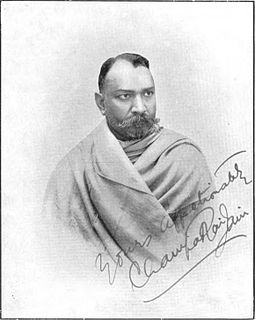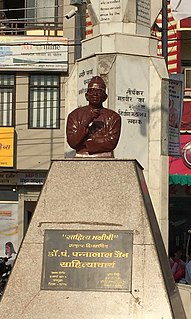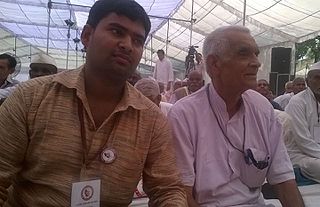 W
WMadhusudan Amilal Dhaky was an architectural and art historian from Gujarat, India. He had written extensively on Indian temple architecture, Jain literature and art.
 W
WChampat Rai Jain (1867–1942) was a Digambara Jain born in Delhi and who studied and practiced law in England. He became an influential Jainism scholar and comparative religion writer between 1910s and 1930s who translated and interpreted Digambara texts. In early 1920s, he became religiously active in India and published essays and articles defending Jainism against misrepresentations by colonial era Christian missionaries, contrasting Jainism and Christianity. He founded Akhil Bharatvarsiya Digambara Jain Parisad in 1923 with the aim of activist reforms and uniting the south Indian and north Indian Digambara community. He visited various European countries to give lectures on Jainism. He was conferred with the title Vidya-Varidhi by Bharata Dharma Mahamandal.
 W
WPandit Niraj Jain was a scholar of Jainism, archaeologist, poet and speaker. His contributions to Jain studies span nearly 60 years. He was also an expert on Urdu poetry, which is unusual for a Jain scholar. He was associated with several organisations. He also lectured on the Ramayana He was a proponent of preserving historical nature of ancient temples. He had travelled and lectured widely in India and overseas .
 W
WSahityacharya Dr. Pandit Pannalal Jain (1911–2001) was a distinguished Jain scholar. Dr. Kasturchand Kasliwal has regarded him as among the 20 most distinguished of the Jain scholars of 20th century His teaching career spanned 70 years, from 1931 to 2001.
 W
WJambuvijaya (1923–2009), also known as Muni Jambuvijayji Maharajsaheb, was a monk belonging to the Tapa Gaccha order of Svetambara sect of Jainism. He was known for his pioneering work in research, cataloguing and translations of Jain Agamas and ancient texts. He was responsible for discovering and publishing many ancient Jains texts lying in different forgotten Jain jnana bhandaras. He was a disciple of Muni Punyavijay. Both Muni Punyavijay and Jambuvijay worked all their life in the compilation and publication of ancient Jain Agama literature and cataloguing ancient Jain jnana bhandaras. Muni Jambuvijay was a scholar who devoted his entire life to critically editing Jain scriptures.
 W
WNathuram Premi was a writer, publisher, poet, editor, and linguist in the field of Jainism as well as Hindi literature. A budding poet, he wrote under the nom de plume of "Premi". Although belonging to the Digambara sect of Jainism, he adopted a non-sectarian attitude and published and translated many Digambara as well as Śvetāmbara works. Working as a clerk in a firm in Mumbai he rose to establish his own publishing house and bookstore Hindi Granth Ratnākar Kāryālay which published works of many of the biggest names in Indian literature, including Munshi Premchand, Hajariprasad Dvivedi, Jainendrakumar, Yashpal, Swami Satyabhakta, Sharatchandra Chatterjee and Rabindranath Tagore. The bookshop and publishing house now called Hindi Granth Karyalay is now being managed by his grandson and great-grandson 100 years after its establishment.
 W
WShrimad Rajchandra was a Jain poet, mystic, philosopher, scholar and reformer. Born near Morbi, he claimed to have recollection of his past lives at the age of seven. He performed Avadhāna, a memory retention and recollection test that gained him popularity, but he later discouraged it in favour of his spiritual pursuits. He wrote much philosophical poetry including Atma Siddhi. He also wrote many letters and commentaries and translated some religious texts. He is best known for his teachings on Jainism and his spiritual guidance to Mahatma Gandhi.
 W
WRatnasundarsuri is an Indian Jain monk, activist and Gujarati language writer. He is well known for his lectures on spirituality and social issues.
 W
WSukhlal Sanghvi, also known as Pandit Sukhlalji, was a Jain scholar and philosopher. He belonged to the Sthanakvasi sect of Jainism. Pandit Sukhlal lost his eyesight at the age of sixteen on account of smallpox. However, he overcame this handicap and became profoundly versed in Jain logic and rose to become a professor at Banaras Hindu University. Paul Dundas calls him one of the most incisive modern interpreters of Jain philosophy. Dundas notes that Sanghavi represents what now seems to be a virtually lost scholarly and intellectual world. He was a mentor for famous Jain scholar Padmanabh Jaini. During his lifetime he won such awards as the Sahitya Akademi Award and won recognition from the Government of India by getting Padma Bhushan award. Sukhlalji was also known as Pragnachaksu because he was so vastly learned despite being visually challenged.
 W
WSwami Satyabhakta was an Indian scholar, philosopher, reformer and the founder of Satya Samaj.
 W
WRamjee Singh is a former Member of Parliament and vice-chancellor of Jain Vishva Bharati University. He is an eminent Gandhian and is the author of a number of books on him. He was also the director of Gandhian Institute of Studies, Varanasi, India. In January 2020 he was awarded the fourth highest civilian award in the country: The Padma Shri for Social Work. His life has been a blend of being a Gandhian academician as well as an activist. Singh has declared Mahatma Gandhi as the Bodhisattva of the 20th century.
 W
WAcharya Vijay Vallabhsuri was a Jain monk. He was a disciple of Vijayanandsuri. He worked in Punjab so he was given honorific Punjab Kesari.
 W
WPanyas Chandrashekhar Vijayji Maharaj Saheb, also known as Gurudev or Guruma, was a Jain monk, scholar and author. Born and educated in Mumbai, he was initiated as a monk who later designated Panyas. He was involved in religious as well as sociopolitical activities. He founded several institutions and authored 261 books.